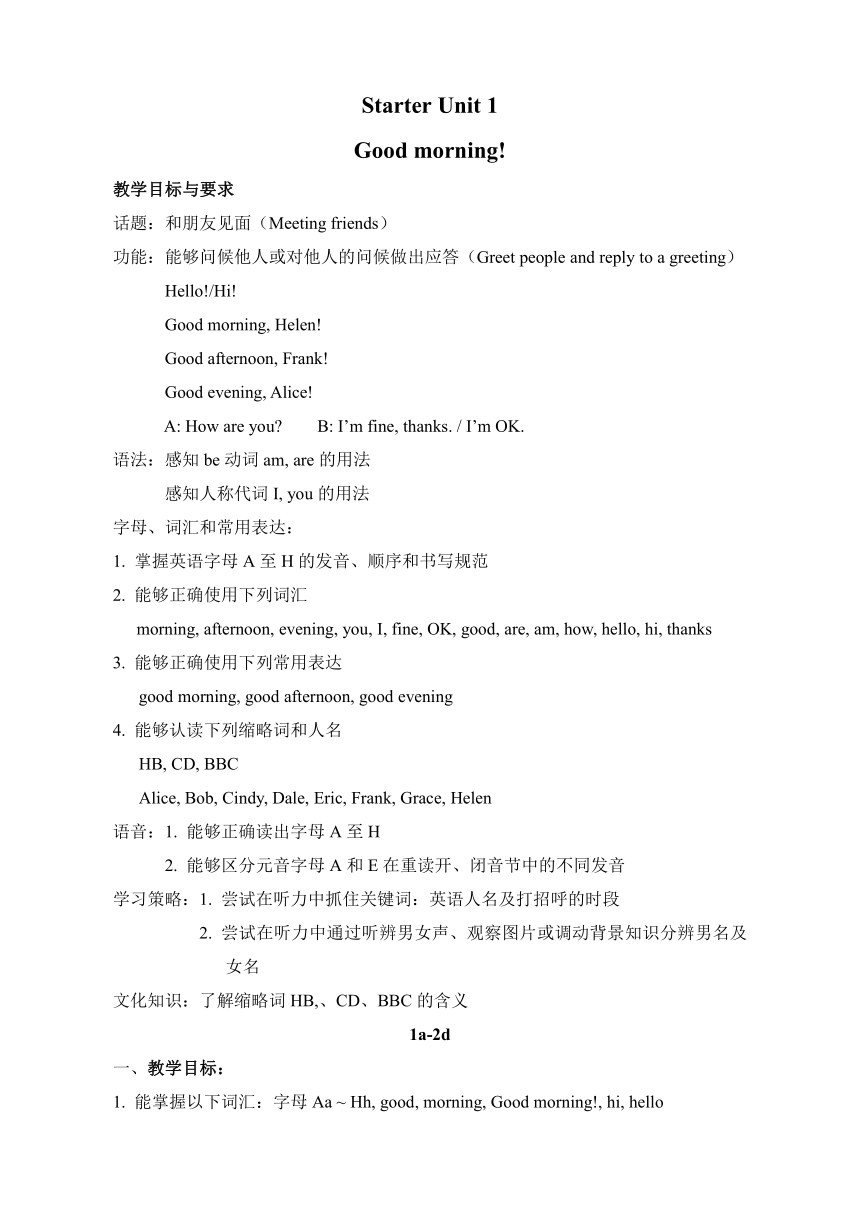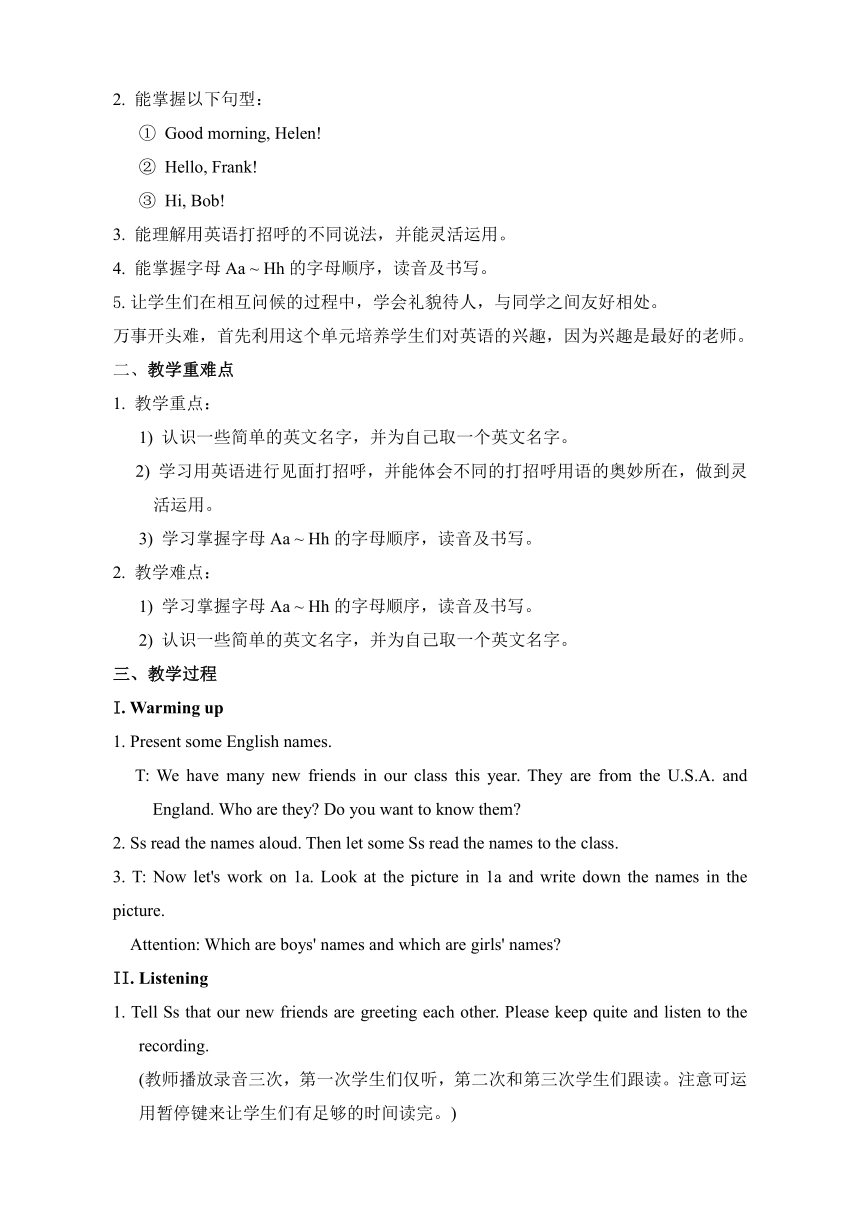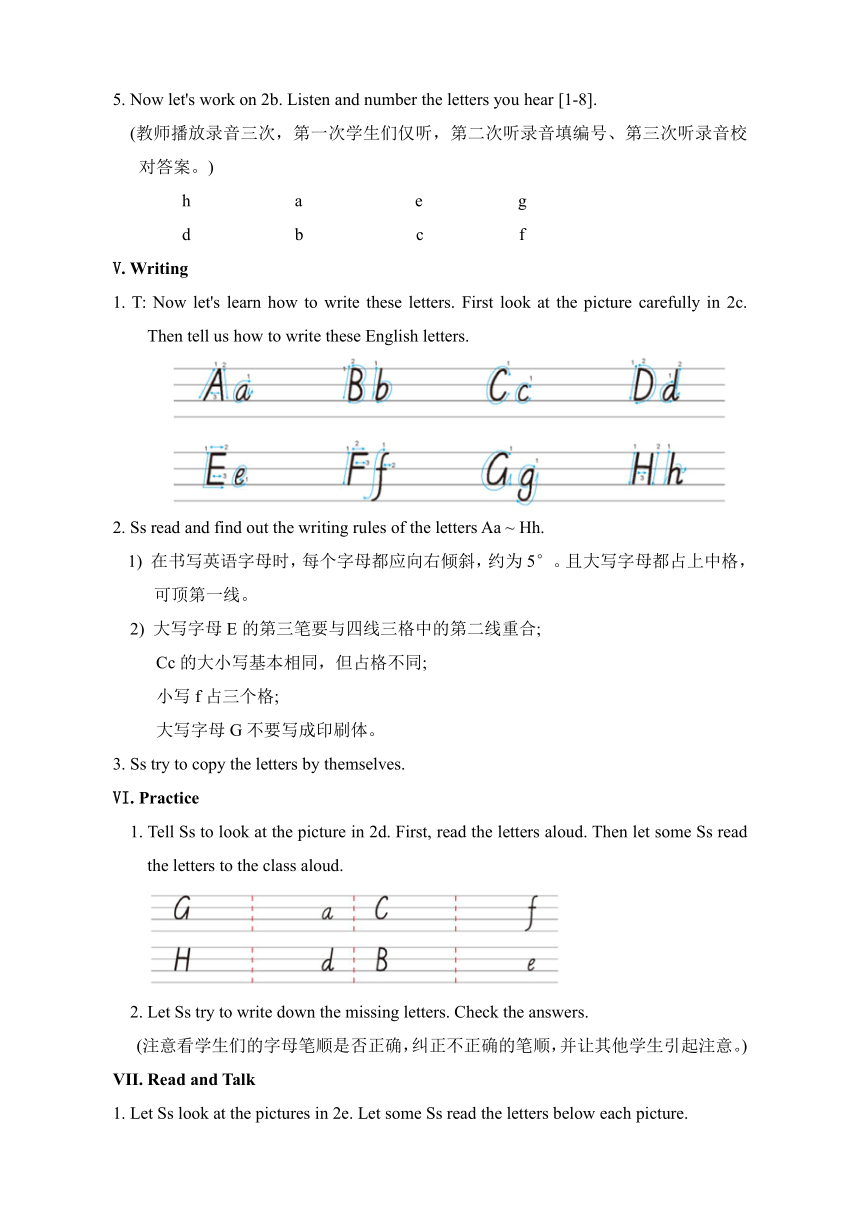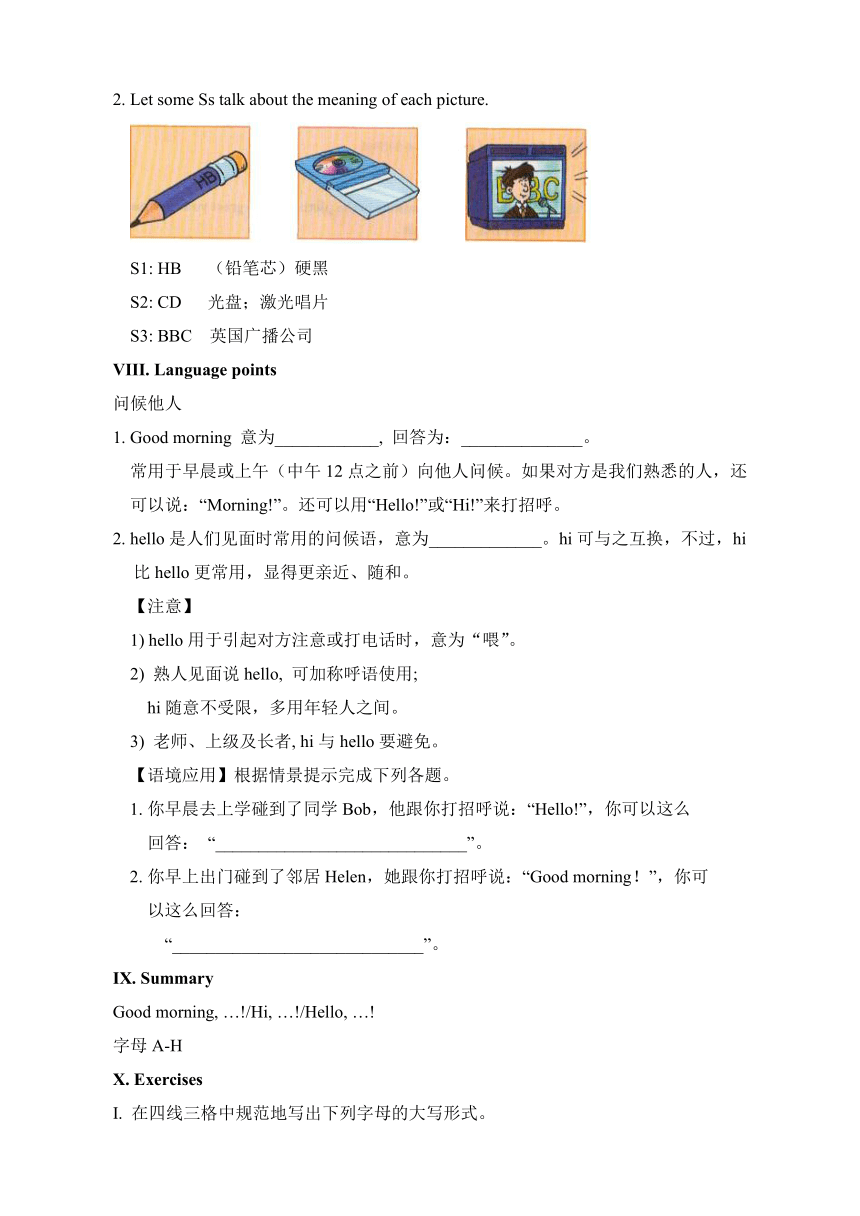Starter Unit 1 Good morning 教案(2课时 13页)
文档属性
| 名称 | Starter Unit 1 Good morning 教案(2课时 13页) |  | |
| 格式 | zip | ||
| 文件大小 | 1.6MB | ||
| 资源类型 | 教案 | ||
| 版本资源 | 人教新目标(Go for it)版 | ||
| 科目 | 英语 | ||
| 更新时间 | 2021-09-24 23:03:30 | ||
图片预览





文档简介
Starter
Unit
1
Good
morning!
教学目标与要求
话题:和朋友见面(Meeting
friends)
功能:能够问候他人或对他人的问候做出应答(Greet
people
and
reply
to
a
greeting)
Hello!/Hi!
Good
morning,
Helen!
Good
afternoon,
Frank!
Good
evening,
Alice!
A:
How
are
you?
B:
I’m
fine,
thanks.
/
I’m
OK.
语法:感知be动词am,
are的用法
感知人称代词I,
you的用法
字母、词汇和常用表达:
1.
掌握英语字母A至H的发音、顺序和书写规范
2.
能够正确使用下列词汇
morning,
afternoon,
evening,
you,
I,
fine,
OK,
good,
are,
am,
how,
hello,
hi,
thanks
3.
能够正确使用下列常用表达
good
morning,
good
afternoon,
good
evening
4.
能够认读下列缩略词和人名
HB,
CD,
BBC
Alice,
Bob,
Cindy,
Dale,
Eric,
Frank,
Grace,
Helen
语音:1.
能够正确读出字母A至H
2.
能够区分元音字母A和E在重读开、闭音节中的不同发音
学习策略:1.
尝试在听力中抓住关键词:英语人名及打招呼的时段
2.
尝试在听力中通过听辨男女声、观察图片或调动背景知识分辨男名及女名
文化知识:了解缩略词HB,、CD、BBC的含义
1a-2d
一、教学目标:
1.
能掌握以下词汇:字母Aa
~
Hh,
good,
morning,
Good
morning!,
hi,
hello
2.
能掌握以下句型:
①
Good
morning,
Helen!
②
Hello,
Frank!
③
Hi,
Bob!
3.
能理解用英语打招呼的不同说法,并能灵活运用。
4.
能掌握字母Aa
~
Hh的字母顺序,读音及书写。
5.让学生们在相互问候的过程中,学会礼貌待人,与同学之间友好相处。
万事开头难,首先利用这个单元培养学生们对英语的兴趣,因为兴趣是最好的老师。
二、教学重难点
1.
教学重点:
1)
认识一些简单的英文名字,并为自己取一个英文名字。
2)
学习用英语进行见面打招呼,并能体会不同的打招呼用语的奥妙所在,做到灵活运用。
3)
学习掌握字母Aa
~
Hh的字母顺序,读音及书写。
2.
教学难点:
1)
学习掌握字母Aa
~
Hh的字母顺序,读音及书写。
2)
认识一些简单的英文名字,并为自己取一个英文名字。
三、教学过程
I.
Warming
up
1.
Present
some
English
names.
T:
We
have
many
new
friends
in
our
class
this
year.
They
are
from
the
U.S.A.
and
England.
Who
are
they?
Do
you
want
to
know
them?
2.
Ss
read
the
names
aloud.
Then
let
some
Ss
read
the
names
to
the
class.
3.
T:
Now
let's
work
on
1a.
Look
at
the
picture
in
1a
and
write
down
the
names
in
the
picture.
Attention:
Which
are
boys'
names
and
which
are
girls'
names?
II.
Listening
1.
Tell
Ss
that
our
new
friends
are
greeting
each
other.
Please
keep
quite
and
listen
to
the
recording.
(教师播放录音三次,第一次学生们仅听,第二次和第三次学生们跟读。注意可运用暂停键来让学生们有足够的时间读完。)
2.
Ss
listen
and
repeat
after
the
recording.
III.
Pair
work
1.(让学生们看1a图画中的人物的对话,告诉学生图画中有三组对话,分别是Bob与Helen的对话;Dale与Eric及Frank的对话;Cindy与Alice的对话。)
T:
You
are
Bob,
your
partner
is
Helen.
You
are
Dale,
your
partners
are
Eric
and
Frank.
Then
you
are
Cindy,
your
partner
is
Alice.
Practice
the
conversations.
Ss
practice
the
conversations
in
pairs.
T:
Exchange
the
roles.
And
practice
the
conversations
again.
Ss
exchange
the
roles
and
practice
the
conversations
again.
2.
运用刚学的句型,并用刚才自己所选择的英文名字来相互问候。
S1:
Good
morning,
Cindy!
S2:
Hello,
Frank!
S3:
Good
morning,
Grace!
S4:
Hi,
Bob!
IV.
Listening
1.
播放英文字母歌。
2.
(告诉学生们英语中有26个英语字母,它们就像我们汉语的笔画一样是构成单词的要素。下面我们先来学习字母Aa
~
Hh。其中A、B、C、D、E、F、G、H是大写字母;a、b、c、d、e、f、g、h是小写字母。)
A
a
B
b
C
c
D
d
E
e
F
f
G
g
H
h
2.
教师播放录音三次,第一次学生们仅听,第二次和第三次学生们跟读。注意可运用暂停键来让学生们有足够的时间读完。
3.
Let
some
Ss
read
out
the
letters
Aa
~
Hh.
(注意纠正学生们不准确的读音)
4.
Let
Ss
try
to
remember
the
letters
Aa
~
Hh.
5.
Now
let's
work
on
2b.
Listen
and
number
the
letters
you
hear
[1-8].
(教师播放录音三次,第一次学生们仅听,第二次听录音填编号、第三次听录音校对答案。)
h
a
e
g
d
b
c
f
V.
Writing
1.
T:
Now
let's
learn
how
to
write
these
letters.
First
look
at
the
picture
carefully
in
2c.
Then
tell
us
how
to
write
these
English
letters.
2.
Ss
read
and
find
out
the
writing
rules
of
the
letters
Aa
~
Hh.
1)
在书写英语字母时,每个字母都应向右倾斜,约为5°。且大写字母都占上中格,可顶第一线。
2)
大写字母E的第三笔要与四线三格中的第二线重合;
Cc的大小写基本相同,但占格不同;
小写f占三个格;
大写字母G不要写成印刷体。
3.
Ss
try
to
copy
the
letters
by
themselves.
VI.
Practice
1.
Tell
Ss
to
look
at
the
picture
in
2d.
First,
read
the
letters
aloud.
Then
let
some
Ss
read
the
letters
to
the
class
aloud.
2.
Let
Ss
try
to
write
down
the
missing
letters.
Check
the
answers.
(注意看学生们的字母笔顺是否正确,纠正不正确的笔顺,并让其他学生引起注意。)
VII.
Read
and
Talk
1.
Let
Ss
look
at
the
pictures
in
2e.
Let
some
Ss
read
the
letters
below
each
picture.
2.
Let
some
Ss
talk
about
the
meaning
of
each
picture.
S1:
HB
(铅笔芯)硬黑
S2:
CD
光盘;激光唱片
S3:
BBC
英国广播公司
VIII.
Language
points
问候他人
1.
Good
morning
意为____________,
回答为:______________。
常用于早晨或上午(中午12点之前)向他人问候。如果对方是我们熟悉的人,还可以说:“Morning!”。还可以用“Hello!”或“Hi!”来打招呼。
2.
hello是人们见面时常用的问候语,意为_____________。hi可与之互换,不过,hi比hello更常用,显得更亲近、随和。
【注意】
1)
hello用于引起对方注意或打电话时,意为“喂”。
2)
熟人见面说hello,
可加称呼语使用;
hi随意不受限,多用年轻人之间。
3)
老师、上级及长者,
hi与hello要避免。
【语境应用】根据情景提示完成下列各题。
1.?你早晨去上学碰到了同学Bob,他跟你打招呼说:“Hello!”,你可以这么
回答:
“_____________________________”。
2.?你早上出门碰到了邻居Helen,她跟你打招呼说:“Good
morning!”,你可
以这么回答:
“_____________________________”。
IX.
Summary
Good
morning,
…!/Hi,
…!/Hello,
…!
字母A-H
X.
Exercises
I.
在四线三格中规范地写出下列字母的大写形式。
II.
将方框中的英文名按性别分类。
Dale,
Alice,
Bob,
Cindy,
Eric,
Grace,
Helen,
Frank
男孩名:_______________________________
女孩名:_______________________________
Homework
1.
练习用英语问候你的朋友们。
2.
背诵字母Aa到Hh。
3a-4d
一、教学目标:
1.
能掌握以下词汇:afternoon,
evening,
how,
are,
you,
I,
am,
fine,
thanks,
OK
2.
能掌握以下句型:
①
Good
afternoon!
②
Good
evening!
3.
能在一天中不同的时候问候朋友们。会询问朋友的近况。
4.
总结归纳元音字母Aa与Ee在单词中的常见发音规律。
5.
让学生们在相互问候的过程中,学会礼貌待人,与同学之间友好相处。
万事开头难,首先利用这个单元培养学生们对英语的兴趣,因为兴趣是最好的老师。
二、教学重难点
1.
教学重点:
1)
就相互问候的话题开展听、说的训练。
2)
总结归纳元音字母Aa与Ee在单词中的常见发音规律。
3)
学习唱课本S4中问候他人的歌曲。
2.
教学难点:
总结归纳元音字母Aa与Ee在单词中的常见发音规律。
三、教学过程
I.Review
1.
Write
the
names.
Boys’
names:
Girls’
names:
2.
默写上节课所学的英语字母。
3.
判断下列各组字母的大小写,一致的打“√”,不一致的打“×”。
F
e
(
)
B
d
(
)
A
a
(
)
H
h
(
)
E
f
(
)
D
d
(
)
4.
练习打招呼的句型
II.
Listening
1.
让学生们看3a中的三幅图画,提醒学生们注意图画中的时间,让三名学生分别说出每幅图画发生的时间。
T:
Picture
1.
S1:
下午二点。
T:
Picture
2.
S2:
早上七点多。
T:
Picture
3.
S3:
晚上八点。
2.
T:
How
do
they
greet
their
friends
in
different
time?
Listen
to
the
recording
and
number
the
pictures.
For
the
first
time,
only
listen.
For
the
second
time,
listen
and
number
the
pictures.
For
the
third
time,
let's
check
the
answers.
(播放录音三次,第一次仅听;第二次,边听边排号。第三次,听录音,校对答案。)
3.
Summary
①
good
afternoon(下午好)是中午12点到傍晚约6点之间的见面问候语,
答语仍为good
afternoon。
good
evening(晚上好)是傍晚约6点到晚上睡觉之前的见面问候语,
答语仍为
good
evening。
②
在英美等国家的非正式场合及日常口语中,
熟人及朋友之间常用“Morning!”
“Afternoon!”
或“Evening!
”进行问候。
e.g.
Morning,
everyone!
大家早上好!
Evening,
Gina!
晚上好,吉娜!
③
“Good
night”并不是问候语,而是晚上分别时或就寝前的道别用语,
它的含义是
“晚安!”,
答语仍为
“Good
night”。
III.
Pair
work
1.
Let
Ss
practice
the
conversations
in
pairs.
2.
Exchange
the
roles.
And
practice
the
conversations
again.
IV.Pair
work
1.
T:
Now
listen
the
recording.
For
the
first
time
only
listen
and
for
the
second
time,
Ss
listen
and
repeat
after
the
recording.
(Ss
listen
to
the
recording
and
repeat
after
the
recording.)
T:
You
are
Dale,
your
partner
is
Cindy.
Practice
the
conversations
with
your
partner.
(Ss
practice
the
conversations
in
pairs.)
T:
Exchange
the
roles.
And
practice
the
conversations
again.
(Ss
exchange
the
roles
and
practice
the
conversations
again.)
2.
Explanation:
How
are
you?
较熟悉的人之间见面时常用的问候语,但并不是想深入交谈某人的健康状况,只是一种礼貌的问候方式。
常用答语为:
Fine./I’m
fine.
/
I’m
(very)well.
/I’m
OK.
意为
“我很好”,并常用
“Thank
you.”
或“Thanks.
”表示感谢。
出于礼貌,
还可用
“How
are
you?”或
“And
you?”问候对方。
这时可以用:I’m
fine,
too./
Fine,
too./
Not
(too)
bad,
thank
you.等作答。
e.g.
--
Hi,
Frank!
How
are
you?
--
I’m
fine,
thanks.
How
are
you?/And
you?
--
I’m
fine
too.
3.
运用刚学的句型,并用自己的英文名字来相互问候。
S1:
Good
afternoon,
Frank!
S2:
Hi,
Grace!
How
are
you?
S1:
I'm
fine,
thanks.
How
are
you?
S2:
I'm
OK.
…
V.
Writing
Look
at
the
children
in
the
picture
in
4a.
Who
can
tell
us
their
names?
2.
Now
write
the
names
of
the
children
under
each
picture.
If
you
can't
remember
their
names,
you
can
turn
to
S1.
Then
check
the
answers
with
your
partner.
Let
some
Ss
read
their
answers.
3.
Now
write
the
names
in
alphabetical
order
in
the
right
box.
(Tell
Ss
what
the
meaning
of
“in
alphabetical
order”
is.)
Ss
work
with
their
partners
and
write
the
names
in
the
right
box
in
alphabetical
order.
Let
some
Ss
read
the
names
to
check
the
answers.
4.
Group
work
Collect
your
group
members’
English
name
and
put
them
in
alphabetical
order.
VI.
Pronunciation
1.
Let's
work
on
4b.
(告诉学生们这是有关元音字母a和字母e的在单词中读音规则的总结,同学们认真听,看能否听清左右两个方框中发音的不同。)
Play
the
recording
twice.
2.
让学生们说出字母a与e在单词中的两种发音,看学生们是否听清。然后教给学生们字母a与e在单词中的两种发音。
/e?/
/i:/
a
e
/?/
/e/
3.
Play
the
recording
again
for
the
Ss
to
listen
and
repeat.
VII.
Practice
1.
Now
let's
work
on
4c.
First,
let's
read
the
words
and
letters
in
column
1.
(Ss
read
the
words
and
letters
in
column
1
aloud.)
?
1
2
A
A
H
Dale
Grace
age
Frank
thanks
hand
E
B
C
D
E
G
evening
he
F
Helen
bed
2.
Look
at
the
words
in
column
2.
Can
you
read
them
out?
(提醒学生右栏中的单词中元音字母的发音与左栏中的读音一样。)
3.
Let
some
Ss
try
to
read
the
words.
Correct
their
pronunciation.
4.
语音学习
英语单词中元音字母的发音与字母的名称常常不一致
。例如:字母a本身可以发
等,而包含a的字母组合又发不同的音。所幸英语中很多单词的发
音是有规律可寻的,下面来学习一些拼读规则。
开音节和闭音节
开音节是以元音字母结尾的音节,如he、go等。还有一种情况也是开音节,即一
个元音字母后接一个辅音字母和不发音的e构成的音节,如Dale、Grace等。
以辅音字母结尾的音节叫闭音节,如bed、hand等。
字母Aa在闭音节中发
音。
如:fat胖的。
字母Aa在开音节中发
音。
如:cake蛋糕。
字母Bb在一般情况下发音。
如:black黑色的。
字母Cc放在词首一般发
音,放在e,
i,
y前一般发音。
如:cute可爱的,science科学。
字母Dd在一般情况下发
音。
如:desk书桌。
字母Ee在闭音节中一般发音;在开音节中发音。
如:闭音节词bed
床;开音节词me我。
字母Ff一般发音。
如:fan扇子;
foot脚。
字母Gg一般发音。
如:good好的;gift礼物。
VIII.
Singing
1.
Let
Ss
read
the
songs
aloud
first.
2.
Listen
to
the
song
and
sing
the
song
together.
IX.
Language
points
大写字母的用法:
1)
英语句子中第一个词的第一个字母要大写。如:How
are
you?
你好吗?
2)
表示人名、地名、国名、某国人或某种语言等的专有名词的第一个字母必须大写。
如:Lucy
Beijing
China
Chinese
English
3)
表示职业、头衔或称呼的名词的第一个字母要大写。如:Uncle
Lee
Doctor
Wang
4)
字母I作人称代词“我”时,在句中任何位置都必须大写。日常用语OK在句中任何位置都大写。
5)
表示月份、星期、重要节日的名词的第一个字母必须大写。如:
May
Monday
New
Year’s
Day
6)
某些缩略词的每一个字母都必须大写。如:BBC
CD
HB
EMS
RMB
CCTV等。
7)
电影名、书名、报刊、文章的标题等中的每一个实词(如名词、动词、形容词、副词、数词)的第一个字母一般大写。
如:
English
Weekly
《英语周报》
Titanic
《泰坦尼克号》
X.
Summary
Good
morning!
Good
afternoon!
Good
evening!
How
are
you?
I’m
fine,
thank
you
/
thanks!
I’m
OK.
XI.
Exercises
Ⅰ.?找出与所给单词划线部分发音相同的选项。
(???
)1.
thanks
A.?am???
????
????
B.?afternoon?
????
?C.?are
(???
)2.?Eric
A.
key???????
???
B.?evening????
??
C.
Helen
(???
)3.
Grace
A.
Frank???
????
B.?Alice???????
C.
Dale
Ⅱ.?选出与下列时间相对应的问候语。
Ⅲ.?从右栏中找出左栏各句对应的应答语。
(???
)1.
How
are
you?
(???
)2.
Good
afternoon,
Bob.
(???
)3.
Hi,
Alice.
(???
)4.
Good
evening,
Alan.
?
A.
Hi!
B.
Good
evening.
C.
Fine.
D.
Good
afternoon.
Homework
1.
按字母表顺序默写字母A到H的大写与小写。
2.
与你的搭档组织小对话表演,用英语进行问候。
Unit
1
Good
morning!
教学目标与要求
话题:和朋友见面(Meeting
friends)
功能:能够问候他人或对他人的问候做出应答(Greet
people
and
reply
to
a
greeting)
Hello!/Hi!
Good
morning,
Helen!
Good
afternoon,
Frank!
Good
evening,
Alice!
A:
How
are
you?
B:
I’m
fine,
thanks.
/
I’m
OK.
语法:感知be动词am,
are的用法
感知人称代词I,
you的用法
字母、词汇和常用表达:
1.
掌握英语字母A至H的发音、顺序和书写规范
2.
能够正确使用下列词汇
morning,
afternoon,
evening,
you,
I,
fine,
OK,
good,
are,
am,
how,
hello,
hi,
thanks
3.
能够正确使用下列常用表达
good
morning,
good
afternoon,
good
evening
4.
能够认读下列缩略词和人名
HB,
CD,
BBC
Alice,
Bob,
Cindy,
Dale,
Eric,
Frank,
Grace,
Helen
语音:1.
能够正确读出字母A至H
2.
能够区分元音字母A和E在重读开、闭音节中的不同发音
学习策略:1.
尝试在听力中抓住关键词:英语人名及打招呼的时段
2.
尝试在听力中通过听辨男女声、观察图片或调动背景知识分辨男名及女名
文化知识:了解缩略词HB,、CD、BBC的含义
1a-2d
一、教学目标:
1.
能掌握以下词汇:字母Aa
~
Hh,
good,
morning,
Good
morning!,
hi,
hello
2.
能掌握以下句型:
①
Good
morning,
Helen!
②
Hello,
Frank!
③
Hi,
Bob!
3.
能理解用英语打招呼的不同说法,并能灵活运用。
4.
能掌握字母Aa
~
Hh的字母顺序,读音及书写。
5.让学生们在相互问候的过程中,学会礼貌待人,与同学之间友好相处。
万事开头难,首先利用这个单元培养学生们对英语的兴趣,因为兴趣是最好的老师。
二、教学重难点
1.
教学重点:
1)
认识一些简单的英文名字,并为自己取一个英文名字。
2)
学习用英语进行见面打招呼,并能体会不同的打招呼用语的奥妙所在,做到灵活运用。
3)
学习掌握字母Aa
~
Hh的字母顺序,读音及书写。
2.
教学难点:
1)
学习掌握字母Aa
~
Hh的字母顺序,读音及书写。
2)
认识一些简单的英文名字,并为自己取一个英文名字。
三、教学过程
I.
Warming
up
1.
Present
some
English
names.
T:
We
have
many
new
friends
in
our
class
this
year.
They
are
from
the
U.S.A.
and
England.
Who
are
they?
Do
you
want
to
know
them?
2.
Ss
read
the
names
aloud.
Then
let
some
Ss
read
the
names
to
the
class.
3.
T:
Now
let's
work
on
1a.
Look
at
the
picture
in
1a
and
write
down
the
names
in
the
picture.
Attention:
Which
are
boys'
names
and
which
are
girls'
names?
II.
Listening
1.
Tell
Ss
that
our
new
friends
are
greeting
each
other.
Please
keep
quite
and
listen
to
the
recording.
(教师播放录音三次,第一次学生们仅听,第二次和第三次学生们跟读。注意可运用暂停键来让学生们有足够的时间读完。)
2.
Ss
listen
and
repeat
after
the
recording.
III.
Pair
work
1.(让学生们看1a图画中的人物的对话,告诉学生图画中有三组对话,分别是Bob与Helen的对话;Dale与Eric及Frank的对话;Cindy与Alice的对话。)
T:
You
are
Bob,
your
partner
is
Helen.
You
are
Dale,
your
partners
are
Eric
and
Frank.
Then
you
are
Cindy,
your
partner
is
Alice.
Practice
the
conversations.
Ss
practice
the
conversations
in
pairs.
T:
Exchange
the
roles.
And
practice
the
conversations
again.
Ss
exchange
the
roles
and
practice
the
conversations
again.
2.
运用刚学的句型,并用刚才自己所选择的英文名字来相互问候。
S1:
Good
morning,
Cindy!
S2:
Hello,
Frank!
S3:
Good
morning,
Grace!
S4:
Hi,
Bob!
IV.
Listening
1.
播放英文字母歌。
2.
(告诉学生们英语中有26个英语字母,它们就像我们汉语的笔画一样是构成单词的要素。下面我们先来学习字母Aa
~
Hh。其中A、B、C、D、E、F、G、H是大写字母;a、b、c、d、e、f、g、h是小写字母。)
A
a
B
b
C
c
D
d
E
e
F
f
G
g
H
h
2.
教师播放录音三次,第一次学生们仅听,第二次和第三次学生们跟读。注意可运用暂停键来让学生们有足够的时间读完。
3.
Let
some
Ss
read
out
the
letters
Aa
~
Hh.
(注意纠正学生们不准确的读音)
4.
Let
Ss
try
to
remember
the
letters
Aa
~
Hh.
5.
Now
let's
work
on
2b.
Listen
and
number
the
letters
you
hear
[1-8].
(教师播放录音三次,第一次学生们仅听,第二次听录音填编号、第三次听录音校对答案。)
h
a
e
g
d
b
c
f
V.
Writing
1.
T:
Now
let's
learn
how
to
write
these
letters.
First
look
at
the
picture
carefully
in
2c.
Then
tell
us
how
to
write
these
English
letters.
2.
Ss
read
and
find
out
the
writing
rules
of
the
letters
Aa
~
Hh.
1)
在书写英语字母时,每个字母都应向右倾斜,约为5°。且大写字母都占上中格,可顶第一线。
2)
大写字母E的第三笔要与四线三格中的第二线重合;
Cc的大小写基本相同,但占格不同;
小写f占三个格;
大写字母G不要写成印刷体。
3.
Ss
try
to
copy
the
letters
by
themselves.
VI.
Practice
1.
Tell
Ss
to
look
at
the
picture
in
2d.
First,
read
the
letters
aloud.
Then
let
some
Ss
read
the
letters
to
the
class
aloud.
2.
Let
Ss
try
to
write
down
the
missing
letters.
Check
the
answers.
(注意看学生们的字母笔顺是否正确,纠正不正确的笔顺,并让其他学生引起注意。)
VII.
Read
and
Talk
1.
Let
Ss
look
at
the
pictures
in
2e.
Let
some
Ss
read
the
letters
below
each
picture.
2.
Let
some
Ss
talk
about
the
meaning
of
each
picture.
S1:
HB
(铅笔芯)硬黑
S2:
CD
光盘;激光唱片
S3:
BBC
英国广播公司
VIII.
Language
points
问候他人
1.
Good
morning
意为____________,
回答为:______________。
常用于早晨或上午(中午12点之前)向他人问候。如果对方是我们熟悉的人,还可以说:“Morning!”。还可以用“Hello!”或“Hi!”来打招呼。
2.
hello是人们见面时常用的问候语,意为_____________。hi可与之互换,不过,hi比hello更常用,显得更亲近、随和。
【注意】
1)
hello用于引起对方注意或打电话时,意为“喂”。
2)
熟人见面说hello,
可加称呼语使用;
hi随意不受限,多用年轻人之间。
3)
老师、上级及长者,
hi与hello要避免。
【语境应用】根据情景提示完成下列各题。
1.?你早晨去上学碰到了同学Bob,他跟你打招呼说:“Hello!”,你可以这么
回答:
“_____________________________”。
2.?你早上出门碰到了邻居Helen,她跟你打招呼说:“Good
morning!”,你可
以这么回答:
“_____________________________”。
IX.
Summary
Good
morning,
…!/Hi,
…!/Hello,
…!
字母A-H
X.
Exercises
I.
在四线三格中规范地写出下列字母的大写形式。
II.
将方框中的英文名按性别分类。
Dale,
Alice,
Bob,
Cindy,
Eric,
Grace,
Helen,
Frank
男孩名:_______________________________
女孩名:_______________________________
Homework
1.
练习用英语问候你的朋友们。
2.
背诵字母Aa到Hh。
3a-4d
一、教学目标:
1.
能掌握以下词汇:afternoon,
evening,
how,
are,
you,
I,
am,
fine,
thanks,
OK
2.
能掌握以下句型:
①
Good
afternoon!
②
Good
evening!
3.
能在一天中不同的时候问候朋友们。会询问朋友的近况。
4.
总结归纳元音字母Aa与Ee在单词中的常见发音规律。
5.
让学生们在相互问候的过程中,学会礼貌待人,与同学之间友好相处。
万事开头难,首先利用这个单元培养学生们对英语的兴趣,因为兴趣是最好的老师。
二、教学重难点
1.
教学重点:
1)
就相互问候的话题开展听、说的训练。
2)
总结归纳元音字母Aa与Ee在单词中的常见发音规律。
3)
学习唱课本S4中问候他人的歌曲。
2.
教学难点:
总结归纳元音字母Aa与Ee在单词中的常见发音规律。
三、教学过程
I.Review
1.
Write
the
names.
Boys’
names:
Girls’
names:
2.
默写上节课所学的英语字母。
3.
判断下列各组字母的大小写,一致的打“√”,不一致的打“×”。
F
e
(
)
B
d
(
)
A
a
(
)
H
h
(
)
E
f
(
)
D
d
(
)
4.
练习打招呼的句型
II.
Listening
1.
让学生们看3a中的三幅图画,提醒学生们注意图画中的时间,让三名学生分别说出每幅图画发生的时间。
T:
Picture
1.
S1:
下午二点。
T:
Picture
2.
S2:
早上七点多。
T:
Picture
3.
S3:
晚上八点。
2.
T:
How
do
they
greet
their
friends
in
different
time?
Listen
to
the
recording
and
number
the
pictures.
For
the
first
time,
only
listen.
For
the
second
time,
listen
and
number
the
pictures.
For
the
third
time,
let's
check
the
answers.
(播放录音三次,第一次仅听;第二次,边听边排号。第三次,听录音,校对答案。)
3.
Summary
①
good
afternoon(下午好)是中午12点到傍晚约6点之间的见面问候语,
答语仍为good
afternoon。
good
evening(晚上好)是傍晚约6点到晚上睡觉之前的见面问候语,
答语仍为
good
evening。
②
在英美等国家的非正式场合及日常口语中,
熟人及朋友之间常用“Morning!”
“Afternoon!”
或“Evening!
”进行问候。
e.g.
Morning,
everyone!
大家早上好!
Evening,
Gina!
晚上好,吉娜!
③
“Good
night”并不是问候语,而是晚上分别时或就寝前的道别用语,
它的含义是
“晚安!”,
答语仍为
“Good
night”。
III.
Pair
work
1.
Let
Ss
practice
the
conversations
in
pairs.
2.
Exchange
the
roles.
And
practice
the
conversations
again.
IV.Pair
work
1.
T:
Now
listen
the
recording.
For
the
first
time
only
listen
and
for
the
second
time,
Ss
listen
and
repeat
after
the
recording.
(Ss
listen
to
the
recording
and
repeat
after
the
recording.)
T:
You
are
Dale,
your
partner
is
Cindy.
Practice
the
conversations
with
your
partner.
(Ss
practice
the
conversations
in
pairs.)
T:
Exchange
the
roles.
And
practice
the
conversations
again.
(Ss
exchange
the
roles
and
practice
the
conversations
again.)
2.
Explanation:
How
are
you?
较熟悉的人之间见面时常用的问候语,但并不是想深入交谈某人的健康状况,只是一种礼貌的问候方式。
常用答语为:
Fine./I’m
fine.
/
I’m
(very)well.
/I’m
OK.
意为
“我很好”,并常用
“Thank
you.”
或“Thanks.
”表示感谢。
出于礼貌,
还可用
“How
are
you?”或
“And
you?”问候对方。
这时可以用:I’m
fine,
too./
Fine,
too./
Not
(too)
bad,
thank
you.等作答。
e.g.
--
Hi,
Frank!
How
are
you?
--
I’m
fine,
thanks.
How
are
you?/And
you?
--
I’m
fine
too.
3.
运用刚学的句型,并用自己的英文名字来相互问候。
S1:
Good
afternoon,
Frank!
S2:
Hi,
Grace!
How
are
you?
S1:
I'm
fine,
thanks.
How
are
you?
S2:
I'm
OK.
…
V.
Writing
Look
at
the
children
in
the
picture
in
4a.
Who
can
tell
us
their
names?
2.
Now
write
the
names
of
the
children
under
each
picture.
If
you
can't
remember
their
names,
you
can
turn
to
S1.
Then
check
the
answers
with
your
partner.
Let
some
Ss
read
their
answers.
3.
Now
write
the
names
in
alphabetical
order
in
the
right
box.
(Tell
Ss
what
the
meaning
of
“in
alphabetical
order”
is.)
Ss
work
with
their
partners
and
write
the
names
in
the
right
box
in
alphabetical
order.
Let
some
Ss
read
the
names
to
check
the
answers.
4.
Group
work
Collect
your
group
members’
English
name
and
put
them
in
alphabetical
order.
VI.
Pronunciation
1.
Let's
work
on
4b.
(告诉学生们这是有关元音字母a和字母e的在单词中读音规则的总结,同学们认真听,看能否听清左右两个方框中发音的不同。)
Play
the
recording
twice.
2.
让学生们说出字母a与e在单词中的两种发音,看学生们是否听清。然后教给学生们字母a与e在单词中的两种发音。
/e?/
/i:/
a
e
/?/
/e/
3.
Play
the
recording
again
for
the
Ss
to
listen
and
repeat.
VII.
Practice
1.
Now
let's
work
on
4c.
First,
let's
read
the
words
and
letters
in
column
1.
(Ss
read
the
words
and
letters
in
column
1
aloud.)
?
1
2
A
A
H
Dale
Grace
age
Frank
thanks
hand
E
B
C
D
E
G
evening
he
F
Helen
bed
2.
Look
at
the
words
in
column
2.
Can
you
read
them
out?
(提醒学生右栏中的单词中元音字母的发音与左栏中的读音一样。)
3.
Let
some
Ss
try
to
read
the
words.
Correct
their
pronunciation.
4.
语音学习
英语单词中元音字母的发音与字母的名称常常不一致
。例如:字母a本身可以发
等,而包含a的字母组合又发不同的音。所幸英语中很多单词的发
音是有规律可寻的,下面来学习一些拼读规则。
开音节和闭音节
开音节是以元音字母结尾的音节,如he、go等。还有一种情况也是开音节,即一
个元音字母后接一个辅音字母和不发音的e构成的音节,如Dale、Grace等。
以辅音字母结尾的音节叫闭音节,如bed、hand等。
字母Aa在闭音节中发
音。
如:fat胖的。
字母Aa在开音节中发
音。
如:cake蛋糕。
字母Bb在一般情况下发音。
如:black黑色的。
字母Cc放在词首一般发
音,放在e,
i,
y前一般发音。
如:cute可爱的,science科学。
字母Dd在一般情况下发
音。
如:desk书桌。
字母Ee在闭音节中一般发音;在开音节中发音。
如:闭音节词bed
床;开音节词me我。
字母Ff一般发音。
如:fan扇子;
foot脚。
字母Gg一般发音。
如:good好的;gift礼物。
VIII.
Singing
1.
Let
Ss
read
the
songs
aloud
first.
2.
Listen
to
the
song
and
sing
the
song
together.
IX.
Language
points
大写字母的用法:
1)
英语句子中第一个词的第一个字母要大写。如:How
are
you?
你好吗?
2)
表示人名、地名、国名、某国人或某种语言等的专有名词的第一个字母必须大写。
如:Lucy
Beijing
China
Chinese
English
3)
表示职业、头衔或称呼的名词的第一个字母要大写。如:Uncle
Lee
Doctor
Wang
4)
字母I作人称代词“我”时,在句中任何位置都必须大写。日常用语OK在句中任何位置都大写。
5)
表示月份、星期、重要节日的名词的第一个字母必须大写。如:
May
Monday
New
Year’s
Day
6)
某些缩略词的每一个字母都必须大写。如:BBC
CD
HB
EMS
RMB
CCTV等。
7)
电影名、书名、报刊、文章的标题等中的每一个实词(如名词、动词、形容词、副词、数词)的第一个字母一般大写。
如:
English
Weekly
《英语周报》
Titanic
《泰坦尼克号》
X.
Summary
Good
morning!
Good
afternoon!
Good
evening!
How
are
you?
I’m
fine,
thank
you
/
thanks!
I’m
OK.
XI.
Exercises
Ⅰ.?找出与所给单词划线部分发音相同的选项。
(???
)1.
thanks
A.?am???
????
????
B.?afternoon?
????
?C.?are
(???
)2.?Eric
A.
key???????
???
B.?evening????
??
C.
Helen
(???
)3.
Grace
A.
Frank???
????
B.?Alice???????
C.
Dale
Ⅱ.?选出与下列时间相对应的问候语。
Ⅲ.?从右栏中找出左栏各句对应的应答语。
(???
)1.
How
are
you?
(???
)2.
Good
afternoon,
Bob.
(???
)3.
Hi,
Alice.
(???
)4.
Good
evening,
Alan.
?
A.
Hi!
B.
Good
evening.
C.
Fine.
D.
Good
afternoon.
Homework
1.
按字母表顺序默写字母A到H的大写与小写。
2.
与你的搭档组织小对话表演,用英语进行问候。
同课章节目录
- starters 预备篇(2012秋审查)
- Unit 1 Good morning !
- Unit 2 What’s this in English?
- Unit 3 What color is it ?
- Unit 1 My name's Gina.
- Section A
- Section B
- Unit 2 This is my sister.
- Section A
- Section B
- Unit 3 Is this your pencil?
- Section A
- Section B
- Unit 4 Where's my schoolbag?
- Section A
- Section B
- Unit 5 Do you have a soccer ball?
- Section A
- Section B
- Unit 6 Do you like bananas?
- Section A
- Section B
- Unit 7 How much are these socks?
- Section A
- Section B
- Unit 8 When is your birthday?
- Section A
- Section B
- Unit 9 My favorite subject is science.
- Section A
- Section B
